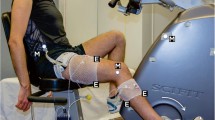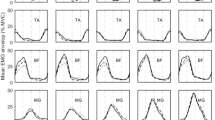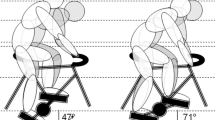Abstract
In the present study, we quantitatively described and compared lower extremity neuromuscular patterns during level cycling (LC), 10 and 20% uphill cycling (UC). We hypothesized that both the timing and intensity of activity of selected lower extremity muscles will differ between steep (but not moderate slope) UC condition and LC. Twelve trained mountain bikers performed an experimental test with three different cycling conditions (level, 10% slope and 20% slope) with EMG monitoring of eight lower extremity muscles. Significant changes (p < 0.05) in muscle activation timing during 20% UC compared to LC (15° later onset and 39° earlier offset) were observed in m. rectus femoris (RF). Range of activity during 20% UC compared to LC was also significantly (p < 0.05) modified in m. vastus medialis, m. vastus lateralis (8° and 5° shorter) and m. biceps femoris (BF; 17° longer). Furthermore, a reduction of EMG activity level was observed for RF and m. tibialis anterior (TA) during 20% UC compared to LC (25 and 19%; p < 0.05), while the opposite effect was observed for m. gluteus maximus (GM; 12%; p < 0.05). Peak cross-correlation coefficients in all cycling conditions for all muscles were high (all coefficients ≥0.83). We have shown that altered body orientation during steep, but not moderate, slope UC significantly modified the timing and intensity of several lower extremity muscles, the most affected being those that cross the hip joint and TA. The observed modifications in neuromuscular patterns during 20% UC could have a significant effect on lower extremity joint kinetics and cycling efficiency.



Similar content being viewed by others
References
Bertucci W, Grappe F, Groslambert A (2007) Laboratory vs outdoor cycling conditions: differences in pedalling biomechanics. J Appl Biomech 23(2):87–92
Bertucci W, Grappe F, Girard A, Betik A, Rouillon JD (2005) Effects on the crank torque profile when changing pedalling cadence in level ground and uphill road cycling. J Biomech 38:1003–1010
Bini RR, Diefenthaeler F (2009) Mechanical work and coordinative pattern of cycling: a literature review. Kinesiology 41:25–39
Caldwell G, Hagberg J, McCole S, Li L (1999) Lower extremity joint moments during uphill cycling. J Appl Biomech 15:166–181
Cannon DT, Kolkhorst FW, Cipriani DJ (2007) Effect of pedaling technique on muscle activity and cycling efficiency. Eur J Appl Physiol 99:659–664
Chapman AR, Vicenzino B, Blanch P, Knox JJ, Dowlan S, Hodges PW (2008) The influence of body position on leg kinematics and muscle recruitment during cycling. J Sci Med Sport 11:519–526
Clarys JP, Alewaeters K, Zinzen E (2001) The influence of geographic variations on the muscular activity in selected sports movements. J Electromyogr Kinesiol 11:451–457
Dorel S, Couturier A, Hug F (2008a) Influence of different racing positions on mechanical and electromyographic patterns during pedalling. Scand J Med Sci Sports 19:44–54
Dorel S, Couturier A, Hug F (2008b) Intra-session repeatability of lower limb muscles activation pattern during pedaling. J Electromyogr Kinesiol 18:857–865
Duc S, Bertucci W, Pernin J, Grappe F (2008) Muscular activity during uphill cycling: effect of slope, posture, hand grip position and constrained bicycle lateral sways. J Electromyogr Kinesiol 18:116–127
Enoka RM (2008) Neuromechanics of human movement. Hum Kinet, Champaign
Ericson M (1986) On the biomechanics of cycling. A study of joint and muscle load during exercise on the bicycle ergometer. Scand J Rehabil Med Suppl 16:1–43
Ericson MO, Nisell R, Arborelius UP, Ekholm J (1985) Muscular activity during ergometer cycling. Scand J Rehabil Med 17:53–61
Fonda B, Sarabon N (2010a) Biomechanics of cycling: literature review. Sport Sci Rev 19:131–163
Fonda B, Sarabon N (2010b) Effects of adjusting seat position and seat tilt during uphill cycling (In Slovenian). Šport 58:40–41
Gregor RJ, Conconi F (2000) Anatomy, biochemistry and physiology of road cycling. In: Gregor RJ, Conconi F (eds) Road cycling: Olympic handbook of sports medicine. Wiley-Blackwell, New York, pp 1–17
Hansen EA, Waldeland H (2008) Seated versus standing position for maximization of performance during intense uphill cycling. J Sports Sci 26:977–984
Hansen EA, Jørgensen LV, Jensen K, Fregly BJ, Sjøgaard G (2002) Crank inertial load affects freely chosen pedal rate during cycling. J Biomech 35:277–285
Hermens HJ, Freriks B, Disselhorst-Klug C, Rau G (2000) Development of recommendations for SEMG sensors and sensor placement procedures. J Electromyogr Kinesiol 10:361–374
Herzog W (2000) Muscle properties and coordination during voluntary movement. J Sports Sci 18:141–152
Hof AL (2002) EMG and muscle force: an introduction. Hum Mov Sci 3:119–153
Hug F, Dorel S (2009) Electromyographic analysis of pedaling: a review. J Electromyogr Kinesiol 19:182–198
Hug F, Bendahan D, Le Fur Y, Cozzone PJ, Grelot L (2004) Heterogeneity of muscle recruitment pattern during pedaling in professional road cyclists: a magnetic resonance imaging and electromyography study. Eur J Appl Physiol 92:334–342
Hug F, Drouet JM, Champoux Y, Couturier A, Dorel S (2008) Interindividual variability of electromyographic patterns and pedal force profiles in trained cyclists. Eur J Appl Physiol 104:667–678
Lepers R, Hausswirth C, Maffiuletti N, Brisswalter J, van Hoecke J (2000) Evidence of neuromuscular fatigue after prolonged cycling exercise. Med Sci Sports Exerc 32:1880–1886
Li L, Caldwell GE (1998) Muscle coordination in cycling: effect of surface incline and posture. J Appl Physiol 85:927–934
Lunnen JD, Yack J, LeVeau BF (1981) Relationship between muscle length, muscle activity, and torque of the hamstring muscles. Phys Ther 61:190–195
Neptune RR, Kautz SA, Hull ML (1997) The effect of pedaling rate on coordination in cycling. J Biomech 30:1051–1058
Peiffer JJ, Losco B (2011) Reliability/validity of the Fortius trainer. Int J Sports Med 32:353–356
Raasch CC, Zajac FE (1999) Locomotor strategy for pedaling: muscle groups and biomechanical functions. J Neurophysiol 82:515–525
Ryan MM, Gregor R (1992) EMG profiles of lower extremity muscles during cycling at constant workload and cadence. J Electromyogr Kinesiol 2:69–80
Sanderson DJ, Amoroso AT (2009) The influence of seat height on the mechanical function of the triceps surae muscles during steady-rate cycling. J Electromyogr Kinesiol 19:465–471
Savelberg HHCM, van de Port IGL, Willems PJB (2003) Body configuration in cycling affects muscle recruitment and movement pattern. J Appl Biomech 19:310–324
Suzuki S, Watanabe S, Homma S (1982) EMG activity and kinematics of human cycling movements at different constant velocities. Brain Res 240:245–258
Too D (1990) Biomechanics of cycling and factors affecting performance. Sports Med 10:286–302
Wren TAL, Do KP, Rethlefsen SA, Healy B (2006) Cross-correlation as a method for comparing dynamic electromyography signals during gait. J Biomech 39:2714–2718
Acknowledgments
This study was supported in part by the Ministry of Science, Education and Sport Grant no. 034-034-2607-2623 (G.M.).
Author information
Authors and Affiliations
Corresponding author
Additional information
Communicated by Jean-René Lacour.
Rights and permissions
About this article
Cite this article
Sarabon, N., Fonda, B. & Markovic, G. Change of muscle activation patterns in uphill cycling of varying slope. Eur J Appl Physiol 112, 2615–2623 (2012). https://doi.org/10.1007/s00421-011-2236-1
Received:
Accepted:
Published:
Issue Date:
DOI: https://doi.org/10.1007/s00421-011-2236-1




